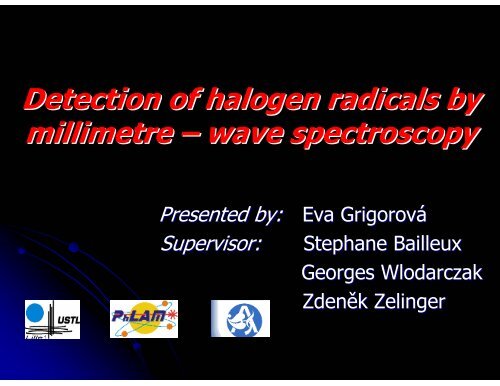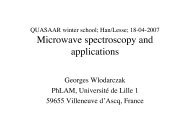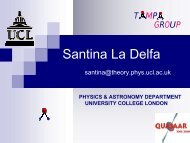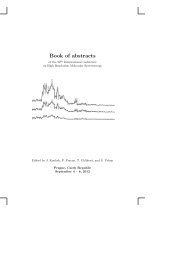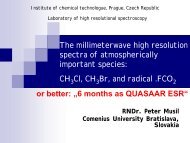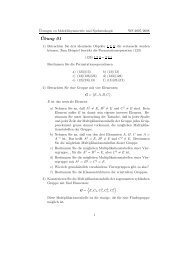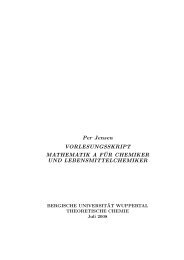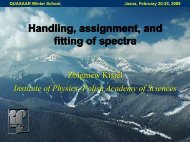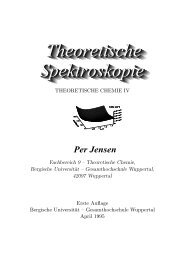Detection of halogen radicals by millimetre – wave spectroscopy
Detection of halogen radicals by millimetre – wave spectroscopy
Detection of halogen radicals by millimetre – wave spectroscopy
Create successful ePaper yourself
Turn your PDF publications into a flip-book with our unique Google optimized e-Paper software.
<strong>Detection</strong> <strong>of</strong> <strong>of</strong> <strong>halogen</strong> <strong>radicals</strong> <strong>by</strong> <strong>by</strong><br />
<strong>millimetre</strong> <strong>–</strong><strong>–</strong> <strong>wave</strong> <strong>wave</strong> <strong>spectroscopy</strong><br />
Presented Presented <strong>by</strong>: <strong>by</strong>: Eva Grigorová Grigorov<br />
Supervisor: Supervisor: Stephane Bailleux<br />
Georges Wlodarczak<br />
Zdeněk Zelinger
VŠB- Technical University <strong>of</strong><br />
Ostrava, faculty <strong>of</strong> Safety<br />
engineering<br />
eng neering<br />
Branch <strong>of</strong> Study <strong>of</strong> Fire<br />
Protection and Industrial<br />
Safety<br />
Cooperate with J.Heyrovský<br />
J.Heyrovsk<br />
Institute <strong>of</strong> Physical<br />
Chemistry, Academy <strong>of</strong><br />
Sciences <strong>of</strong> Czech Republic<br />
Where Where I I am am from? from?
From October 2006 in Lille 1<br />
University in France<br />
Laboratoire de Physique des<br />
Lasers, Atomes et Molécules Mol cules<br />
(PHLAM)<br />
Study <strong>halogen</strong> <strong>radicals</strong> <strong>radicals</strong><br />
(CH2I) (CH I) <strong>by</strong> mmw<br />
<strong>spectroscopy</strong> and analysis ana ysis <strong>of</strong><br />
ν4 band <strong>of</strong> FCO2 FCO measured<br />
<strong>by</strong> FTIR<br />
Present
Study theoretical<br />
background <strong>of</strong><br />
<strong>spectroscopy</strong><br />
1. 1. Part Part <strong>of</strong> <strong>of</strong> my my work work<br />
How to operate the<br />
spectrometer
2. 2. Part Part <strong>of</strong> <strong>of</strong> my my work work<br />
High igh resolution <strong>spectroscopy</strong> <strong>of</strong> <strong>halogen</strong><br />
Difficult to prepare<br />
short life time - (few ms)<br />
have to choose suitable<br />
<strong>radicals</strong> radical<br />
precursor<br />
preparative process, reaction<br />
physical conditions (pressures,<br />
temperature)<br />
Difficult to detect them<br />
few weak transitions <strong>of</strong> reactive species<br />
many strong lines <strong>of</strong> stable species
Halogen <strong>radicals</strong>s radical CH22XX CH<br />
[ [ X X = = Cl, Cl, F, F, Br, Br, I I ] ]<br />
1) 1) Atmospheric interest<br />
• Reaction: Reaction:<br />
CH 3X X + OH or Cl → CH 2X • Subsequent reactions involving CH 2X X<br />
produce <strong>halogen</strong> atoms atom<br />
• Destr estroying oying stratospheric ozone
2) 2) Spectroscopic interest<br />
• CH 2F F and CH 2Cl Cl: : micro <strong>wave</strong> spectra<br />
published more than 2 decades<br />
ago(Y.Endo et al,1983,1984)<br />
• CH2Br CH Br rotational otational spectrum analyzed<br />
(Bailleux Bailleux et t al, al 2OO5)<br />
• CH2I CH no high resolution spectroscopic<br />
data availa available<br />
ble<br />
• All these <strong>radicals</strong> have planar structure
CH CH22Br<br />
Br radical radical<br />
Come Come<br />
from CH3Br CH Br<br />
natural and anthropogenic source<br />
• In the Atmosphere:<br />
CH 3Br Br + OH → CH 2Br Br + H O 2<br />
• In Laboratory:<br />
CH 3Br Br + Cl → CH 2Br Br + HCl
What What about about CH CH22I<br />
I ??? ???<br />
Difficultiies<br />
Difficult es with with producing and and<br />
detecting<br />
No experimental data <strong>of</strong> rotational rotational<br />
constants constant<br />
How ow to produce ?<br />
CH3Br CH Br + Cl → CH2Br CH Br ...exotherm<br />
... exothermic ic reaction<br />
CH3I CH I + Cl → CH2I CH I ...exo ... exo, , endo... endo...<br />
Not clear<br />
according to papers<br />
Fine and hyperfine splitting: splitting:<br />
II I (5/2)>IBr (5/2)>IBr(3/2)<br />
(3/2)<br />
Lines ines <strong>of</strong> CH 2I I are expected weaker than lines<br />
<strong>of</strong> CH2Br CH Br:<br />
= 0,8 < µ (CH2Br ) = 1<br />
: µ( ( CH2I ) =<br />
< µ(CH2Br )
CH22I CH I radical radical<br />
CH 3I most most<br />
abundant abun ant iodo compound in the<br />
atmosphere<br />
Natural atural source : pelagic ocean,<br />
ocean surface waters, volcanic production<br />
Previous studies studies<br />
Only nly low resolution studies studies<br />
Photoelectron spectra pectra<br />
(L.Adrews L.Adrews et t al,1984 al,1984)<br />
Matrix infrared spectrum<br />
(D.W.Smith D.W.Smith and L.Adrews,1973<br />
L.Adrews,1973)
How How to to detect detect CH22I? CH I?<br />
Based on high level ab initio calculations<br />
calculation<br />
A = 279413,0 MHz B = 8806,1 MHz C = 8537,1 MHz<br />
→ calculated spectrum → graph
Use Use glow glow elecctric ele tric ddiischarge scharge<br />
...easer to use it at first<br />
C-I I chemical bond weaker than C-Br C Br bond<br />
Test on CH2Br CH Br radical - We produced CH2Br CH Br!
CH2I CH I in glow el. discharge ?<br />
• many vibrationally<br />
vibrationally<br />
excited states <strong>of</strong> CH3I CH<br />
Intensity<br />
8<br />
3<br />
-2<br />
-7<br />
-12<br />
Congested spectrum <strong>of</strong> CH3I<br />
450000 450050 450100 450150 450200<br />
Frequency<br />
CH3I
Change to to hydrogen<br />
abstraction with with fluorine<br />
• Atomic tomic fluorine produced in micro<strong>wave</strong> discharge:<br />
Primary reaction:<br />
CH3I CH I + F → CH2I+ CH I+ HF ???<br />
• Test at first on CH2Br CH Br radical<br />
CH2Br CH Br only observed using F 2 !!!
• Secondary reaction:<br />
F + CH 2I I → [CH CH2FI FI] * → CH 2F F + I ???<br />
• Test to detect CH 2F F → Detected !!!<br />
CH 3I I + F → CH 3F F + I → CH 2F F + HI<br />
• Test to detect CH 3F F → Detected!!!
• Searching for lines is still in progress... progress...<br />
• At least observed spectra are not congested...<br />
Intensity<br />
8<br />
3<br />
-2<br />
-7<br />
-12<br />
450080 450085 450090 450095 450100<br />
Frequency<br />
Congested spectrum <strong>of</strong> CH3I<br />
Nocongested spectrum <strong>of</strong><br />
CH3I
Wish Wish<br />
We have seen few paramagnetic lines<br />
(probably probably from CH 2I???) I???) and therefore is<br />
important to continuous in measurement...<br />
measurement...
3. 3. Analysis <strong>of</strong> <strong>of</strong> νν band band <strong>of</strong> <strong>of</strong> FCO<br />
44 FCO2 2<br />
obtained <strong>by</strong> <strong>by</strong> FTIR FTIR<br />
A, B, C rotational constant, centriftugal distortion constants, co stants, fine constants ???
FCO 2<br />
Probably produced during the stratospheric<br />
degradation <strong>of</strong> HFCs<br />
Most stable member amongst carboxy<br />
<strong>radicals</strong> <strong>of</strong> the type XCO 2<br />
[X = H, F,Cl, Br, I, CF 3 , OCF 3 ]<br />
Rotational spectrum in its ground vibrational<br />
state in the range 240-380 GHz (Z. Zelinger<br />
et al,2003) and 210-245 GHz (Z.Zelinger et<br />
al, 2007)
Conclusion<br />
Spectroscopy <strong>of</strong> radical has essential importance importance<br />
for obtaining the information about chemistry in<br />
the atmosphere<br />
We will continuous in measurement...<br />
Long Long time time prospect<br />
After stay in France, France work with Zdeněk Zden k Zelinger<br />
group in J.Heyrovský J.Heyrovsk Institute <strong>of</strong> Physical<br />
Chemistry Academy <strong>of</strong> Sciences <strong>of</strong> Czech Republic<br />
Finish inish my postgraduate study in<br />
VŠB- Technical University <strong>of</strong> Ostrava
Thanks Thanks to to my my supervisors for for<br />
expert expert advice advice and and patience<br />
leading<br />
leading
Thank Thank you you for for your your<br />
attention


